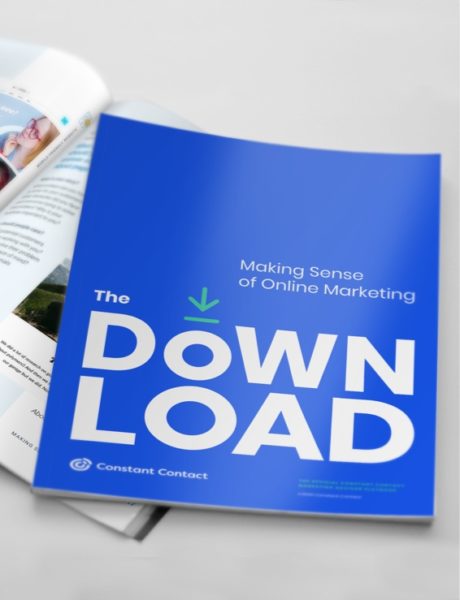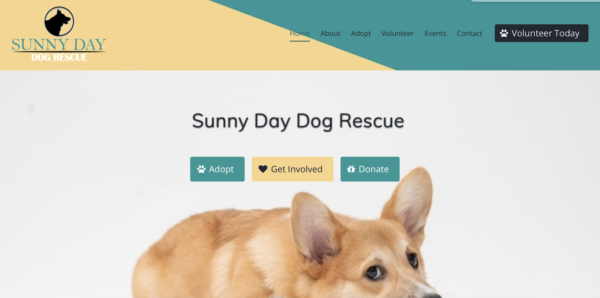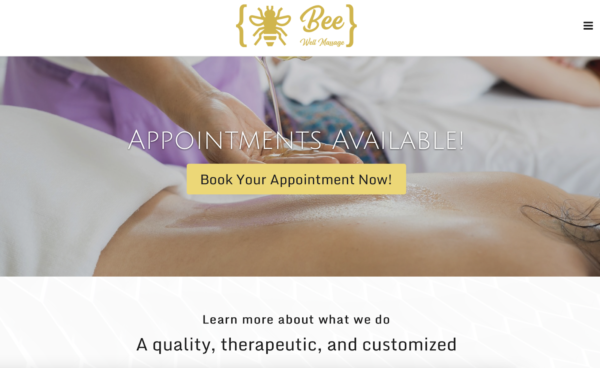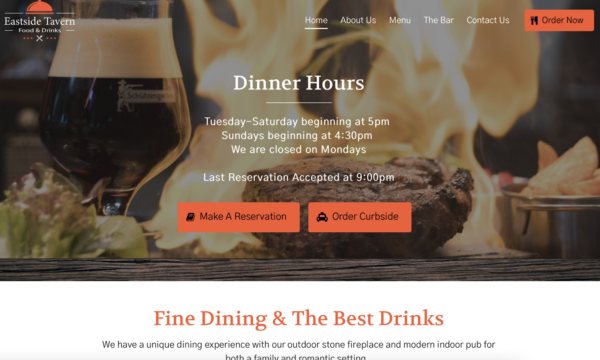
Aaron was a successful entrepreneur teaching people how to grow edible mushrooms at home. But before he decided to redesign the website for his business, he wasn’t sure that his in-person success was reflected online.
For one thing, he hadn’t changed the website in years. When he first started his business, he bought a URL, slapped together a landing page, and got to work on the in-person side of things without giving his website another thought. Cut to a few years later, and everything was outdated. Even his picture on the “Contact Us” page didn’t look like him anymore.
With only a few photos and not a lot of words, his website also didn’t do much to answer the common questions people usually had about his workshops. This meant his business never came up in web searches. He found himself spending a lot of time answering emails while relying too heavily on one social media platform to attract more business.
What’s more, Aaron now wanted to start selling the spawn from which mushrooms grow. He found a source to drop-ship products that he could sell to his students at a discount. But his current website couldn’t perform the tasks he needed. It was time for a redesign — a website that could meet his needs and look good while doing it.
Deciding to redesign a website is a common part of the growth process for business owners throughout all industries, but the changes aren’t always easy. You may get used to the look and feel of an outdated site, and improvements can seem overwhelming and out of reach. Since so many old sites — including Aaron’s — was built years ago by developers who knew code, you may think redesigning a website requires learning a whole new computer language.
Get ready for some good news — website redesign is easier than you think. New tools and best practices from marketing professionals and graphic designers will provide the foundation you’ll need to get your site looking as fresh and modern as your business. In this guide, you’ll learn:
- Reasons to redesign a website
- How to focus on what’s most important
- 4 pages you must have on your website
- What to keep from your old website
- Graphic design tips from the pros
- Tools you can use in the redesign process
Feel free to skip ahead to another section or keep reading to confirm that it’s time to update your digital presence.

Not sure where to start with marketing? That’s why we created The Download.
The Download is the ultimate practical, step-by-step guide to online marketing. In this free guide, we’ll show you how people find you online and how to set yourself up for success to meet your business or nonprofit goals.
Reasons to redesign a website
Aaron’s situation made it clear that he was long overdue for a website redesign, but what about your business website? Ask yourself these important questions before embarking on this big project:
1. Does the design feel outdated?
Especially for companies that have been built over generations, old websites can feel stale. You may have an outdated color palette or a font like “Comic Sans” that is out-of-fashion for modern graphic designers. Perhaps your pictures are dated, or maybe you’ve added new elements to your business that never made it online. You don’t have to know exactly why it feels old; if you think this, your prospective customers probably will too.
2. Does my website function well?
Aaron wasn’t able to add products to his site, making it impossible to expand his business or even capture workshop ticket sales without fielding endless emails. If your website doesn’t perform the functions you need it to, such as being mobile-responsive, it’s time to redesign.
What’s more, a well-designed website includes search engine optimization or SEO for short. If you haven’t integrated this into your current online presence, you’re missing out on the organic (or unpaid) traffic that could find your business through a simple Google search. Don’t worry — this will be covered in more detail later.
3. Have my sales decreased?
In 2020, the coronavirus pandemic dramatically increased the percentage of sales that took place online rather than in stores. Statista.com reports that the 4.2% of sales in 2010 jumped to 15.7% in 2020. In 2021, it was clear that many people have kept the online shopping habit, with 13.6% of all retail sales taking place online.
If your site doesn’t create a warm and welcoming online shopping experience for your new and returning customers, you’ve probably discovered sales are decreasing.
4. Am I spending too much time fielding questions and concerns?
Your website should automate much of your work, fully answering questions and processing sales or other requests without much effort from you. If you are playing catch-up, it’s likely that your website doesn’t have a user-friendly journey ending in excellent customer service.
How to focus on what’s most important
Even though you’re not starting from scratch, it can sure feel like it. To clarify things, focus on what’s most important: your customers.
Understand your audience
A common exercise that marketing professionals will do is to brainstorm an in-depth description of their ideal customer, going well beyond the normal demographics like gender and age. This is known as creating a brand persona, and it includes figuring out your customers’ hobbies, interests, pain points, worries, habits, and a whole host of other traits that you can use to understand them better.
Once you know exactly who you’re trying to reach, it will be easier to pick new colors, tone of voice, and new features for your website. You’ll have a better understanding of how to expand your brand awareness in ways that won’t waste your time. The more you narrow down who you want to reach, the easier it will be.
Remember the purpose of your website
What exactly do you want to do online? Your business should already have a mission statement, which outlines the goals and values of your organization. If not, spend time thinking about what your business does, how it does it, and why. This can also help you focus your website redesign efforts.

Some of the most common reasons why people or businesses have websites are:
- Ecommerce
- Information
- Blog
Lots of websites incorporate all three of these. For example, many business owners today have added informational blogs to their ecommerce websites to connect with people searching for help in their niche market. Still, it’s important to remember the purpose of an ecommerce website is to sell products, not just share information.
Be mobile-responsive
Making sure your website works as well on a mobile device like a smartphone or a tablet as it does on a laptop needs to be a priority for your redesign efforts. Today, nearly 56% of searches take place on a mobile device — and that percentage is only increasing. If your site takes too long to load or is hard to navigate on a small phone screen, your customers will go elsewhere.
4 pages you must have on your website
Now that you’ve determined what you need your website to do and who exactly you want to reach, it’s time to start laying out the navigation for your website redesign. It’s best to create a clear customer journey on your website so that visitors will feel comfortable and curious to spend time learning and exploring your brand.
On each page of your website, your customer should know what you want them to do. If the goal is to increase sales, for example, make sure the only call-to-action is navigation to a sales page. If you give them too many options, they’ll be overwhelmed and hesitate before making a purchase.

That’s why marketing experts recommend keeping the navigation of a website simple. No matter how complex your business is, shoot for no more than five options in your navigation window. These pages should include:
Homepage
This is your first impression, so make sure it immediately portrays your business’s mission, values, and goals. The copy and the photos should appeal to your target audience, and it should be clear right from the start exactly how you can meet their needs and solve their problems.
About Us
Customers do a lot of research these days, so share your story with them. The “About Us” page is an opportunity to share the history of your business, highlight your team members, and provide insight into the personalities behind your brand. Give your customers a reason to work with you rather than with your competition.
Products/Services
Whether you’re selling a product as an ecommerce business or you’re using your website to attract new in-person clients, you can use your website to state your products or services clearly. Spend time fully describing your work or your items and be sure to add unique photos. Think about creating an online experience that matches how it feels for your customers to shop in your store or meet with you individually.
Contact Us
No one likes clicking on a website and not finding the best way to reach someone at the business. If people have to scroll to the bottom of the homepage, click through the team bios, or hunt elsewhere, they will assume that you simply don’t care about customer service. They might think you’re actively avoiding it. So be sure to add a page dedicated to connecting with them in as many ways as possible.
What to keep from your old website
Since you already have a website, you don’t need to reinvent the wheel. But what should you keep and what should you get rid of? The answer is in the research. Use an online platform like Google Analytics to learn where your customers are spending the most time. Find out which pages provide the highest conversion and bring in the highest traffic to your site.
Look at your bounce rate, which is the percentage of visitors who leave your site quickly instead of continuing to another page. If your bounce rate is high, you’ll want to understand why. You can do this by implementing A/B testing for your CTA, or call to action.
For example, let’s say you want your site visitors to download a free guide so you can capture their email addresses and follow up with individualized offerings of your services. The button on your website may say, “Download my guide” or “Get your free guide today.” Track the success of the first wording, and then compare it to the second wording. This will help you see what type of tone will best attract your target audience.

If your old website includes links to testimonials, you’ll want to keep those. Including links to review and listing sites is the modern-day equivalent to the office water cooler. Your customers want to know that you have a good reputation in the community. Sharing positive testimonials as you redesign your business website will encourage them to do business with you too.
Graphic design tips from the pros
When Aaron started working on redesigning his website, he also took the opportunity to update his branding. At the time, his logo was a nondescript Chinese character that barely related to his mushroom business. So he worked with a graphic designer to update his logo to launch simultaneously with his website redesign — and you can too.
Along with updating your branding, other design tips for redesigning a website include:
Keep it simple
It’s the mark of an amateur to try to shoehorn too much into a small area. Your website pages must have adequate white space around text blocks. Make sure your photos or any embedded videos are large enough to be clear, and create white borders around them, too.
There’s a reason why this guide and so many you read employ numbered lists and bullet points. Smaller, bite-sized copy is easier to read on smaller screens.
Pick a font and color palette
The colors you choose for your logo and other elements of your business should be reflected in your website so that visitors can get a feel for your branding no matter where they encounter you. It’s the same for the font you use for the words on your pages.
Choose no more than four colors and two fonts. Use them throughout the redesigned website, as well as in your brochures, letterhead, advertisements, and social media banners. Consistency is an important part of the branding process.
Use a template
Hiring a professional graphic designer to help with your website redesign work can get expensive. If your budget doesn’t allow for it, don’t try to go it alone. Use one of the many templates that are available for free from an online web-building tool.
Templates do more than make it fast and easy to cut and paste your content. These graphic design tools line up elements on a page to appear less cluttered and more appealing to the eye. What’s more, many templates also have built-in SEO features. Your site will look great and rise in the search engine ranking too.
Tools you can use in the website redesign process
Thankfully, there are many free tools you can use to make your new website perform much better than your old version.
Keyword tools
Remember SEO? Part of what you’ll need to do is research what keywords your target audience is using when they are trying to find your business on Google and other search engines. Constant Contact’s SEO tools help you find the best keywords to weave into your site’s content strategically.
Online listing sites
Your redesign website work will be meaningless if you can’t connect with Google Business Profile and other online listing services. To maximize these sites, your business information must be up to date. Constant Contact also integrates these Google tools so your location is always correct on Google Search and Google Maps.
Add photos and links to your website and include information your customers want to know. When someone leaves a review, whether it’s good or bad, always reply professionally as quickly as possible.
Email marketing
Websites can be powerful drivers to encourage potential customers to connect with you, but often their visit to your site is just the beginning. If you can use your website to capture email addresses through a process known as lead generation, you can start creating relationships that can dramatically improve your conversion rates.
Use a lead magnet, a free item or service your customers want, to gather email addresses. Then, create email marketing strategies with discounts, useful information, and news about your business that will keep customers coming back to your site to see what’s new.
Think big picture when you redesign a website
Efforts to redesign a website look and brands take time, but the work can help you reach your business goals. While you’re considering important decisions like colors, fonts, photos, and navigation, make sure you aren’t ignoring the other important elements of a comprehensive marketing plan.




